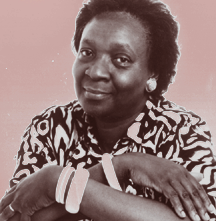

[ Metro | Metroactive Central | Archives ]
Creole Melody
Mangrove in the Promised Land: Maryse Condé
Maryse Condé conjures up Guadeloupe
Every once in a while, snorfling around in the great hog trough of modern American book publishing, one comes upon an absolute apple of a novel, just about perfect in form and taste. For me, that has occurred only rarely in the '90s. The first time was Anne-christine d'Adesky's magnificent novel of post-Duvalier, pre-Aristide Haiti, Under the Bone. And now I've come across a second rare fruit: Maryse Condé's little masterpiece, Crossing the Mangrove.
Crossing the Mangrove is a praise-song to one of the backwaters of the West Indies: Guadeloupe, two leeward islands lying sleepily under the scented, smothering cloak of postcolonial France. Its society is a complex mix of East Indian merchants and laborers, the descendants of slavery-time Africans, French planter-aristocrats and any number of Creole combinations in between.
Condé, a Guadeloupian native, serves up this world on its own terms, nuances intact. Her ability to sort through the intricate interplay of sex, nationality, ethnicity and social standing is impressive. She treats you as a member of the village that is the setting for her story, taking you off the tour bus and dumping you into the Saturday marketplace. You have to hustle at times to keep up with all the references, but I like that. It assumes some intelligence and cultural sensitivity on the part of the reader.
As English readers, we get a useful boost from Richard Philcox, Condé's husband, who translated Crossing the Mangrove (originally titled Traversé de la mangrove and published in 1989) from the French and Guadeloupian Creole, and who confesses to some difficulty finding English equivalents for "those distortions of the French that Creole is so fond of making and at the same time poke fun at standard, academic French." Despite a klunkiness of phrasing here and there, Philcox is able to move us along with some sense that we have tasted the rich spiciness of the original language.
The novel begins with the discovery of the body of one Francis Sancher "[f]ace down in the sticky mud with his clothes soiled, his heavy-built frame and curly mop of salt and pepper hair ... easily recognizable. ... The moon closed its two golden eyes when they rolled over [his] massive body ..., his swollen face turned upwards. The stars did likewise. No light filtered down from the silent sky."
Sancher was an outsider living in the small village of Riviére au Sel, a fugitive from some family curse dangled tantalizingly in front of us throughout the novel's various narratives. No one is sure of Sancher's political background, his family background or even his real name. Former Cuban revolutionary? Doctor? Writer? Speculation abounds. The action takes place at Sancher's wake, in vignettes of the villagers who circle around this strange sun. Some are repelled. Some find guidance in his reflected light. Some are consumed in his fires.
Who killed Francis Sancher? What was he running from? What demons was he seeking as he wandered the daytime woods? What devils caused him to cry out in fear in his nighttime sleep? In trying to answer these questions, his rivals, former lovers, detractors, admirers and mere neighbors end up telling us more about themselves--and about the surging emotional stream that flows just below the surface of even the quietest of human societies. In a way, Sancher's tumultuous intervention into the lives of these villagers is merely an old iron key opening the gateway to their own souls.
Sometimes Condé can be brilliantly simple in her writing, giving us an almost complete portrait within a minimum of words, as when Sancher greets a man who has sent him a long introductory letter: "He looked up at Lucien with magnificent misty eyes floating with dreams and derangement and exclaimed: 'A letter? What a strange idea! I only open my bills.' "
Or in the thoughts of a man whose sister Sancher has seduced and then turned out, pregnant and disgraced: "Stretched out on this carpet of flowers, Aristide was staring at the impervious hard blue sky as if to defy it and convey his anger. He would have liked to be a stone in a catapult so he could put a hole through its forehead."
At other times, Condé can be lyrically beautiful, lushly poetic in her descriptions:
So many American-published novels these days seem written with one eye on the advertising campaign and the other on potential movie rights. To her immense credit, Condé appears to be writing strictly from her heart, and it shows.
Crossing the Mangrove must have been difficult to market. (Ethnic studies or murder mystery? Hmmmm.) And it would be even more difficult to translate to the Hollywood thrill-a-minute screen. All that Mangrove provides is a damn good read, which ought to be the primary goal of every book.
[ Metro | Metroactive Central | Archives ]

Photo by Ulf Anderson/Gamma
Only there, among the giant trees, the mabri, châtaignier, candlewood, mastwood and Caribbean pines, did he feel at home. He would slip into their serene and silent shadows, broken here and there by the twittering of birds. In the days when his father used to speak to him, before jealousy and hatred poisoned the air between them, his father would tell of the times gone by when the rough hand of man had not yet ravished the forests of Guadeloupe and they were teeming with all sorts of birds. Macaws with breasts as red as embers, hornbills with beaks and eyes painted in crimson, fluffy green-and-red parakeets, and parrots that could easily be taught to speak.
Crossing the Mangrove by Maryse Condé; Anchor Books; 208 pages; $10.95 paper.
This page was designed and created by the Boulevards team.
Copyright © 1995 Metro Publishing and Virtual Valley, Inc.